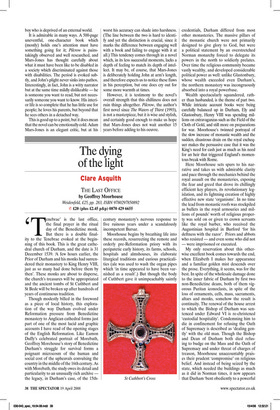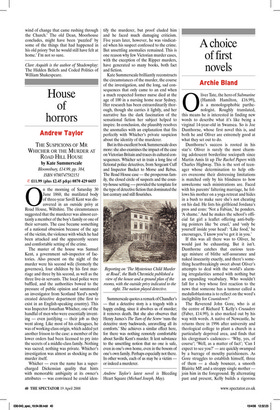The dying of the light
Clare Asquith
THE LAST OFFICE by Geoffrey Moorhouse Weidenfeld, ┬Ż25, pp. 283, ISBN 9780297850892 Ō£å ┬Ż20 (plus ┬Ż2.45 p&p) 0870 429 6655 ŌĆśTenebraeŌĆÖ is the last office, the final prayer in the ritual day of the Benedictine monk. But there is a double finality to the Tenebrae evoked at the beginning of this book. This is the great cathedral church of Durham, and the date is 31 December 1539. ŌĆśA few hours earlier, the Prior of Durham and his monks had surrendered their monastery to King Henry VIII, just as so many had done before them by thenŌĆÖ. These monks are about to disperse, the churchŌĆÖs treasures will be appropriated and the ancient tombs of St Cuthbert and St Bede will be broken up after hundreds of years of continuous tradition.
Though modestly billed in the foreword as a piece of local history, this exploration of the way Durham evolved under Reformation pressure from Benedictine monastery to Anglican cathedral forms just part of one of the most lucid and graphic accounts I have read of the opening stages of the English Reformation. Like Eamon DuffyŌĆÖs celebrated portrait of Morebath, Geoffrey MorehouseŌĆÖs story of Benedictine DurhamŌĆÖs struggle for survival forms a poignant microcosm of the human and social cost of the upheavals convulsing the country in the middle of the 16th century. As with Morebath, the study owes its detail and particularity to an unusually rich archive ŌĆö the legacy, in DurhamŌĆÖs case, of the 15th century monasteryŌĆÖs nervous response to five ruinous years under a scandalously incompetent Bursar.
Moorhouse begins by breathing life into these records, resurrecting the remote and orderly pre-Reformation priory with its peripatetic early history, its farms, schools, hospitals and almshouses, its elaborate liturgical traditions and curious practicalities (ale was used to wash the organ pipes which ŌĆśin time appeared to have been varnished as a resultŌĆÖ.) But though the body of Cuthbert gave it unimpeachably saintly credentials, Durham differed from most other monasteries. The massive pillars of the monastic church were not primarily designed to give glory to God, but were a political statement by an overstretched Norman monarchy forced to delegate its powers in the north to soldierly prelates. Over time the religious community became vastly wealthy, and developed considerable political power as well: unlike Glastonbury, whose wealth exceeded even DurhamŌĆÖs, the northern monastery was incongruously absorbed into a royal powerbase.
Wealth spectacularly squandered, rather than husbanded, is the theme of part two. While intricate account books were being carefully balanced up in Durham, Ely and Glastonbury, Henry VIII was spending millions on extravaganzas such as the Field of the Cloth of Gold, and still more on preparations for war. MoorhouseŌĆÖs twinned portrayal of the slow increase of monastic wealth and the sudden, disastrous drain on the royal exchequer makes the persuasive case that it was the KingŌĆÖs need for cash just as much as his need for an heir that triggered EnglandŌĆÖs momentous break with Rome.
Here Moorhouse sets spurs to his narrative and takes us with admirable clarity and pace through the mechanics behind the royal assault on the monasteries, exposing the fear and greed that drove its chillingly efficient key players, its revolutionary legislation, and its lightning creation of highly effective new state ŌĆśorganismsŌĆÖ. In no time the lead from monastic roofs was stockpiled as bullets in the royal armouries and millions of poundsŌĆÖ worth of religious property was sold on or given to crown servants like the royal barber, who received the Augustinian hospital in Burford ŌĆśfor his deftness with the razorŌĆÖ. Priors and abbots who resisted ŌĆö and even some who did not ŌĆö were imprisoned or executed.
My only reservation about this otherwise excellent book comes towards the end, when Elizabeth I makes her appearance and a familiar golden mist descends over the prose. Everything, it seems, was for the best. In spite of the wholesale damage done to the inner fabric of Durham by first two non-Benedictine deans, both of them vigorous Puritan iconoclasts, in spite of the loss of ornaments, cells, mass, sacraments, altars and monks, somehow the result is continuity. The renewal of the house arrest to which the Bishop of Durham was sentenced under Edward VI is re-christened ŌĆścustodial hospitalityŌĆÖ. Condemning him to die in confinement for refusing the Oath of Supremacy is described as ŌĆśdealing gentlyŌĆÖ with the old man. Though the Bishop and Dean of Durham both died refusing to budge on the Mass and the Oath of Supremacy and under threat of charges of treason, Moorhouse unaccountably praises their prudent ŌĆścompromiseŌĆÖ on religious belief. And instead of being seized by the state, which needed the buildings as much as it did in Norman times, it now appears that Durham ŌĆśbent obediently to a powerful wind of change that came rushing through the Church.ŌĆÖ The old Dean, Moorhouse concludes, might have been ŌĆśpuzzledŌĆÖ by some of the things that had happened in his old priory ŌĆśbut he would still have felt at home.ŌĆÖ IŌĆÖm not so sure.



















































































 Previous page
Previous page